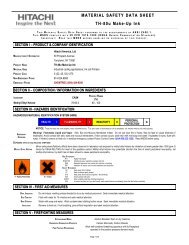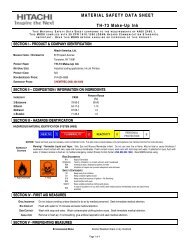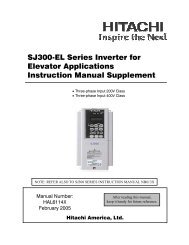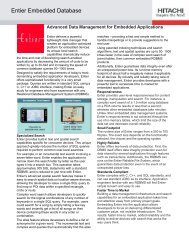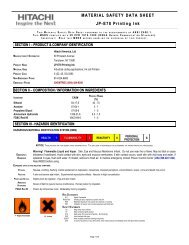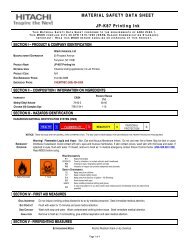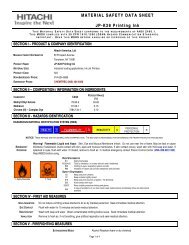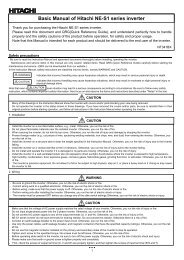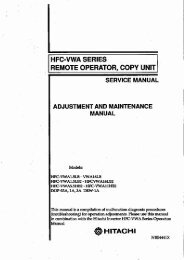How to Make Public Relations Work For You Lauren Garvey, Senior ...
How to Make Public Relations Work For You Lauren Garvey, Senior ...
How to Make Public Relations Work For You Lauren Garvey, Senior ...
You also want an ePaper? Increase the reach of your titles
YUMPU automatically turns print PDFs into web optimized ePapers that Google loves.
eleases should never be more than 2 pages, but in some cases having a release that is3-4 pages is ok.Also issuing a press release with an image is also appropriate provided the pho<strong>to</strong> issomething you feel that an Associated Press wire may pick up, meaning it adds value <strong>to</strong>the s<strong>to</strong>ry and is worth the financial investment.Issuing a high resolution pho<strong>to</strong> is generally priced at $1,000 per pho<strong>to</strong>, you can issuemultiple images but costs are based on per pho<strong>to</strong>Also in addition <strong>to</strong> putting a release across a wire service you can also tailor <strong>to</strong> a specificlist meaning if you were putting out a release on Nutrition and wanted <strong>to</strong> target <strong>to</strong> Nutritionedi<strong>to</strong>rs and Nutrition media you can pay an additional fee <strong>to</strong> do so.Fees typically range anywhere from $500-$1,500Businesswire---a leading wire distribution service offers non-profi<strong>to</strong>rganizations discounts!Business Wire gives all non-profits with 501(c)3 status a discount of 20% off all domesticdistributions. Many non-profits use our <strong>Public</strong> Policy Wire instead of our Business Wire <strong>to</strong>reach key government influencers. Here's a link <strong>to</strong> those distribution channels.www.businesswire.comPitching the Media:This is probably the most important aspect of <strong>Public</strong> <strong>Relations</strong>, writing a good pressrelease is important but unless you “engage or secure” the media’s interest the pressrelease can be meaningless. Also putting out press release across a wire DOES NOTguarantee coverage, you have <strong>to</strong> pitch the media and there are do’s and don’t in how <strong>to</strong>pitch the media.Tips for pitching online include: 1) use a good media database; there are several mediadatabases including: www.baconsmediasource.com or www.bacons.com,www.burrelles.com; each service ranges from $3,000-$4,500 for an annual subscription.Media databases are a critical <strong>to</strong>ol for <strong>Public</strong> <strong>Relations</strong> professionals as reporters areconstantly changing “beats” meaning the types of s<strong>to</strong>ries they cover. When you hear
someone say what is the reporter’s beat it means what is the angle they typically cover.There are city beat reporters, travel beat reporters, financial beat reporters, environmentalbeat reporters, etc.Keep e-mails brief <strong>to</strong> reporter and make sure you get right <strong>to</strong> the point why are youcontacting them and why is your s<strong>to</strong>ry or angle something they should take a close look at.Remember reporters are interested in news, they don’t care about a new campaign, butmay care if it is something unique and over the <strong>to</strong>p. They don’t care about new productsand services unless again it has a unique appeal if you are pitching them on somethingalready out in the marketplace you have <strong>to</strong> get their interest on why yours is different.<strong>You</strong> must must must have a news angle• Using links are okay but just be sure your links work and may it easy for the reporter<strong>to</strong> access and navigate.• Sending reporters attachments—keep in mind reporters will very rarely openattachments only if they requested them, be careful when approaching a reporter,sending large attachments can clog up emails and may “tick” the reporter off. Mosttimes attachments sent <strong>to</strong> reporters will au<strong>to</strong>matically go <strong>to</strong> a spam filter and willau<strong>to</strong>matically deleted• Utilize web-based news sites, Reuters, web libraries and discussion forums;• Target specific reporters and don’t “double pitch” you should never pitch multiplereporters at the same publication unless you cc them all pitching multiple reporterswith the same s<strong>to</strong>ry will “tick them off.” They do talk <strong>to</strong> each other. Now that beingsaid, you can pitch multiple reporters if there is a different news angle for each.• Media databases include: Burrelles/Bacons/Media Map….A media databaseallows you search and create media lists for press release and proactive outreach.• Costs for Media Databases are typically in the range of $3,500 annually…..No PRpractitioner can operate without the use of a good online media database.Press Release Guidelines:VERY VERY IMPORTANT BELOW READ CAREFULLY!!!!
<strong>How</strong> <strong>to</strong> Write a Great Press Release: A Sample PressRelease TemplateWhat is a press release?A press release is pseudo-news s<strong>to</strong>ry, written in third person that seeks <strong>to</strong>demonstrate <strong>to</strong> an edi<strong>to</strong>r or reporter the newsworthiness of a particularperson, event, service or product.<strong>How</strong> is a press release used?Press releases are often sent alone, by e-mail, fax or snail mail. They canalso be part of a full press kit, or may be accompanied by a pitch letter.What is the proper press release format?Here's a sample press release template you can use <strong>to</strong> format your pressrelease correctly:Note: Thethree #'s markthe end of thepress release.What should Iput in mypressrelease?Also you must include a dateline like this:City, State—Month, Date, Year---What's thesecret <strong>to</strong>getting freepublicity? It'snot a fancypress kit. It'snot having asuperstarspokesperson.It's not hiringthe world'sbiggest PRfirm.Actually, theultimate insidersecret is quitesimple:<strong>You</strong> need <strong>to</strong>think like areporter.That's it. Toldyou it wassimple.Of course, this
is the first-place winner in the "easier said than done" Olympics. Most of us are <strong>to</strong>o tied-upin our own world <strong>to</strong> really look at our businesses objectively and come up with anewsworthy s<strong>to</strong>ry angle that can lead <strong>to</strong> free publicity.That's why millions of trees are needlessly slaughtered each year <strong>to</strong> produce pressreleases that will never lead <strong>to</strong> a single news s<strong>to</strong>ry. Reporters have a special place in theircircular file for puffery, flackery and hyperbole. If you want <strong>to</strong> avoid this fate, then you mustlearn <strong>to</strong> think like a reporter.This means:• Being able <strong>to</strong> separate real news about your company from promotional puffery• Being able <strong>to</strong> deliver a sharp s<strong>to</strong>ry angle that will be of real interest <strong>to</strong> the newsreading or viewing public• Being able <strong>to</strong> deliver this angle in a professional, courteous way.Some Basic TruthsHere are some truths that you ignore only at your own risk:1. Reporters don't care about helping you.2. Reporters are hassled all day by PR people and they're pretty much sick of it.Reporters don't care about your website, your book, your products or your life s<strong>to</strong>ry,unless......So what's the bot<strong>to</strong>m line here?When you design your public relations campaign, develop your angles, develop yourmedia materials and begin contacting the press, always think:"What can I do at this step that will make this more useful <strong>to</strong> a journalist?"That means:• developing s<strong>to</strong>ry angles from a reporter's perspective• conducting yourself in a manner free of hype, clichés and puffery• Using proper etiquette when contacting a reporter or edi<strong>to</strong>r
Developing an AngleWhat does it mean <strong>to</strong> "develop a s<strong>to</strong>ry angle from a reporter's perspective"?Step away from your business. View it as a reporter looking for an interesting s<strong>to</strong>ry.Remember, reporter’s are looking for a s<strong>to</strong>ry that will satisfy his edi<strong>to</strong>r and his readers.They are NOT interested in promoting you, only in crafting a s<strong>to</strong>ry that will make readerss<strong>to</strong>p and say "Hmmm, I never knew that. Now there's something I can use!."Here are some "etiquette" secrets that can help you effectively work with journalists ingenerating bushels of free press.....1. Don't call <strong>to</strong> "see if they got your release." Journalists hate this. Folks send outmass mailings and then call <strong>to</strong> see if the release made it there. If you really want <strong>to</strong>get a s<strong>to</strong>ry in the Post, call first <strong>to</strong> pitch your s<strong>to</strong>ry and then follow up with yourrelease, pho<strong>to</strong>s, etc.2. Plan your call around their deadlines. Most papers are morning editions. Thus,journalists' deadlines range from 2 p.m. local time and on. Don't call during thistime! The best time <strong>to</strong> reach a newspaper journalist: 10 a.m. <strong>to</strong> noon local time.3. Don't start pitching right away! If you get Joan Smith on the phone, don't justdive in<strong>to</strong> your pitch. This is rude, as Joan may be on the other line, working on as<strong>to</strong>ry, entertaining guests or who knows what else. Start by saying something like,"Hi Ms. Smith, my name's Bill Jones and I have a s<strong>to</strong>ry suggestion you might findinteresting. Is this a good time for you?" Joan will reply "yes"--which is a green light<strong>to</strong> start your pitch, or "no"-- <strong>to</strong> which you reply, "When would be a good time <strong>to</strong> callyou back?" <strong>You</strong>r courtesy will be greatly appreciated by the journalist...which canonly help your chances.4. Pitch <strong>to</strong> the voice mail. It's fine <strong>to</strong> pitch your s<strong>to</strong>ry <strong>to</strong> the reporter's voice mail.Keep it very short and end the message with your phone number. If you don't hearback, try again until you get the actual reporter or edi<strong>to</strong>r on the phone.5. Don't read from a script! The bane of many journalists' existences are22-year-olds sitting in cubicles in big PR firms reading pitches off a sheet of paper.If you've ever been called by a telemarketer doing the same thing, you know howannoying it can be. Practice your pitch so that it seems natural and spontaneous.6. Give them a s<strong>to</strong>ry, not an advertisement. Newspapers do not exist <strong>to</strong> give youpublicity. They exist <strong>to</strong> provide readers with interesting s<strong>to</strong>ries. <strong>You</strong>r job is <strong>to</strong> givethe journalist what he or she wants, while getting the free exposure. <strong>Make</strong> your
pitch newsy, exciting and relevant. <strong>How</strong> about: "Ms. Smith, as you probably know,obesity among children is growing at an alarming rate. Because of the ridicule theyface from other children, millions of overweight young people are being markedwith lifetime scars that can seriously damage their self-esteem. I host a uniquewebsite, were overweight kids can anonymously express their feelings and discussthis issue. I think I've learned some important things about a very serious subject."That's a whole lot more interesting <strong>to</strong> an edi<strong>to</strong>r than: "Ms. Smith, I have a websitewhere overweight kids post messages. Would you like <strong>to</strong> do a s<strong>to</strong>ry about me?"Follow up immediately. If she's interested, Joan Smith will ask for more information. Besure you have a press kit (including news release and pho<strong>to</strong>) ready <strong>to</strong> send . Send it outvia priority mail, and write "Requested Information" below the address.Call again. Now it's appropriate <strong>to</strong> call <strong>to</strong> see if Joan's received your stuff...after all, unlikea mass-mailed release, she asked for it! Ask if she's had a chance <strong>to</strong> look through it, andwhat she thinks. If she likes what she sees, you're about <strong>to</strong> get some very valuable freepublicity!Keep the following format in mind when writing a press release:• The Headline is critical gets the reporter’s attention• Equally important a subhead• The lead paragraph is critical• Identify s<strong>to</strong>ck symbols (this applies when a company is publicly traded• The name of the company and a description should always be in lead paragraph• Include contact name and number at the end of the release or can be at <strong>to</strong>p• Specify a “release” date• Check for grammar, spelling and accuracy• Always include a boilerplate (ending paragraph on company)• Include quotes from executives or relevant spokespeople• Use statistics when possible, reporters love stats (make sure they are correct)• <strong>You</strong> can use multiple subheads if appropriate• Pyramid style writing—Most important <strong>to</strong> least important
Distinguishing <strong>Public</strong> <strong>Relations</strong> From Marketing,Advertising, <strong>Public</strong>ity, Etc.PUBLIC RELATIONS is the management function that established andmaintains mutually beneficial relationships between an organization and thepublics on whom its success or failure depends.MARKETING is the management function that identifies human needs andwants, offers products and services <strong>to</strong> satisfy those demands, and causestransactions that deliver products and services in exchange for something ofvalue <strong>to</strong> the provider.ADVERTISING is information placed in the media by an identified sponsorthat pays for the time or space. It is a controlled method of placing messagesin the media.PUBLICITY is information by an outside source that is used by the mediabecause the information has news values. It is an uncontrolled method ofplacing messages in the media because the source does not pay the mediafor placement.
INTERNAL RELATIONS is the specialized part of pubic relations that buildsand maintains mutually beneficial relationships between managers and theemployees on whom an organization’s success depends.PRESS AGENTRY is creating newsworthy s<strong>to</strong>ries and events <strong>to</strong> attractmedia attention and <strong>to</strong> gain public notice.PUBLIC AFFAIRS is a specialized part of public relations that builds andmaintains governmental and local community relations in order <strong>to</strong> influencepublic policy.LOBBYING is a specialized part of public relations that builds and maintainsrelations with government primarily for the purpose of influencing legislationand regulation.ISSUES MANAGEMENT is the proactive process of anticipating, identifying,evaluating, and responding <strong>to</strong> public policy issues that affect organizations’relationships with their publics.INVESTOR RELATIONS is a specialized part of corporate public relations
that builds and maintains mutually beneficial relationships with shareholdersand others in the financial community <strong>to</strong> maximize market value.DEVELOPMENT is a specialized part of public relations in nonprofi<strong>to</strong>rganizations that builds and maintains relationships with donors andmembers for the purposes of securing financial and volunteer support.Helpful Ideas in Crafting an Effective PR Campaign:Identify PR Experts Who Can HelpIf you're not a PR pro, that's okay. There are numerous experts you can tap,including officials at your institution. <strong>You</strong> might even want <strong>to</strong> form a PR committee<strong>to</strong> offer and/or help implement ideas.Put the Campaign in WritingPutting the public relations campaign in writing provides a roadmap forimplementing activities leading up <strong>to</strong> and through the season. It is a guide, but it alsohelps hold you and your team accountable for assignments. Also, it is easier <strong>to</strong>evaluate the impact and success of a plan that is in writing. Sections for the planmight include:Objectives
• Target audiences• Tactics• Timing• MeasurementSelect Target AudiencesIdentify key audiences - fans, student-athletes, alumni, the public at large,commercial entities (current or future) and the like - that should be reached and whatwill interest them. These audiences should match those in the overall marketingplan, although PR might not reach all of them.Identify Tactics <strong>to</strong> Communicate <strong>to</strong> Key AudiencesCommunication tactics may include traditional channels, such as media (television,radio, newspapers and magazines) and Web sites, as well as non-media channels,such as grassroots or "word-of-mouth" by groups that are naturally enthusiasticabout the sport or those who have had a positive personal experience with it. Triedand true media tactics include:• News releases - develop a series of news releases that you candistribute <strong>to</strong> media prior <strong>to</strong> and during a season
• Media kit - in addition <strong>to</strong> a news release, include background on thesport, a biography on the coaches, student-athletes, etc., and a factsheet that includes event schedules and locations• Guest articles/op-eds - submit articles written by you or the hostinstitution's athletic direc<strong>to</strong>r <strong>to</strong> local papers• Deskside visits - you or the coach visit local media <strong>to</strong> createconnection and dialogue, and generate coverage• Local radio and/or local TV media <strong>to</strong>urs - offer <strong>to</strong> go on air and talkabout the sport <strong>to</strong> build excitement• <strong>Public</strong> service announcements - develop 30- or 60-secondannouncements for on-air personalities <strong>to</strong> read over the radio• News conference - gather media for a pre-season look at the teamDon't underestimate the importance and potential impact of non-mediachannels. Word-of-mouth can be considerably important in generating enthusiasmfor a team, especially in a campus setting. Non-media channels might include:• Civic organizations• Chambers of commerce• Booster clubs• Athletic clubs and associations• Campus and community leaders
Spokesperson: Appoint a knowledgeable spokesperson who can talk with mediaabout the team and season. This person should be available for news conferences,phone interviews, on-air interviews, media conference calls, etc.Implementing the CampaignMedia <strong>Relations</strong>Create awareness and interest in the championship by actively promoting the team <strong>to</strong>the media.Media Selection: Compile a list of media contacts that includes radio, television,Web, and local publications. When selecting media contacts, consider your targetaudiences and the time it will take media <strong>to</strong> cover the team; give yourself ample time<strong>to</strong> "pitch" your s<strong>to</strong>ry and the media outlet ample time <strong>to</strong> write/publish or air it.General Tactics or Strategies:• Call or e-mail media contacts <strong>to</strong> introduce yourself. Ask for a phone orin-person briefing <strong>to</strong> review/discuss each outlet's interest and plan forcovering the season and how you can be a resource for them. Also askfor details on deadlines, needs, procedures, including how they prefer<strong>to</strong> receive news about the team. Listen <strong>to</strong> their ideas - and offer yourown.
• <strong>For</strong> instance:oA menu of s<strong>to</strong>ry opportunities including statistics, anticipatedmiles<strong>to</strong>nes, records, etc., economic impact, ancillary events.<strong>You</strong>r local newspaper might consider enhancing its coverage ifyou offer an way <strong>to</strong> help educate its readers in some way.oA media kit that summarizes the event, participants, schedule,etc.oTopics for guest articles or on-air interviews by your designatedspokesperson.o<strong>Public</strong> service announcements that could be published or airedregarding the championship.oNews conference schedule.• Keep each media outlet's goals in mind. If the outlet focuses on men'ssports, do not pitch a women's soccer student-athlete for aninterview. If the outlet focuses on general news, relate your event <strong>to</strong>the community, (e.g., the economic impact of the team on thecity). <strong>Make</strong> sure whatever you pitch is news!
• When emailing media, be concise. Shorter is better. Never sendattachments. unless they are requested; embed the copy in the body ofyour email.• Do not call <strong>to</strong> criticize media. Remember how many people,organizations and interest groups are "battling" for space or airtime.Press ReleasesPress releases help inform media of team-related news and events and can serve as asummary prior <strong>to</strong> news conferences in order <strong>to</strong> help them frame questions. If a pressrelease contains a great deal of background statistics, then the release is a great <strong>to</strong>olfor journalists who may need additional information <strong>to</strong> write a completes<strong>to</strong>ry. Follow these guidelines when preparing a press release:1. Think of the press release as a quick look at the highlights of the even<strong>to</strong>r announcement.2. Never write longer than two pages. Keep sentences short. Keepparagraphs short.
3. Include the five W's - Who, What, Where, When, Why - in the first orsecond paragraph. The rest of the press release covers"<strong>How</strong>."4. Spell every name correctly. Names are misspelled in press releases all<strong>to</strong>o often.5. Every press release must be typewritten. Leave one-inch margins anddouble space.6. Include the name of the contact person at your organization. In casemore information is needed, include more than one telephone numberand an email address.7. Do the press release NOW. Old news is useless news. Write itimmediately. Email and/or fax it.8. Find an angle <strong>to</strong> make your press release unique.9. If the media outlet chooses <strong>to</strong> read your news release on the air, orpublish it in the newspaper, they probably will shorten it by eliminatingthe information found at the bot<strong>to</strong>m of the release. So, be sure thatvital details are not at the bot<strong>to</strong>m. Rule of thumb: only the first twoparagraphs may make it in the newspaper. <strong>Make</strong> sure the mostimportant information is at the <strong>to</strong>p.10. If pho<strong>to</strong>graphs accompany a press release, include a brief captionand send as high resolution file, but don’t just send pho<strong>to</strong>s if not asked
can clog up “email systems.” Include names, dates and locations forEVERY pho<strong>to</strong>graph.Handling a Crisis SituationDevelop a plan for communicating with the media in the event that the sportbecomes involved in some type of public relations crisis (i.e., an accident involvingplayers or specta<strong>to</strong>rs, illegal use of banned substances by players/coaches,etc.) Although the crisis communication plan may not be utilized, it is better from apublic relations standpoint <strong>to</strong> be proactive rather than reactive if such a circumstanceshould occur. The following guidelines are suggested <strong>to</strong> prepare for communicationwith the media during a crisis:1. Identify the Type of Crisis that Might be Encountered. A crucialstep in the formation of the crisis communication plan is <strong>to</strong> identify thecrisis situations that the event is most likely <strong>to</strong> face. Successful eventmanagement includes thinking worst-case scenarios and preparing forthem.2. Develop a Strategy. Identify a broad philosophy for dealing with acrisis if it does happen. Have a number of focused strategies in place<strong>to</strong> deal with specific types of crises. A strategy should be set in
advance for management of the crisis and the primary goal of thisstrategy should be the protection of participants, specta<strong>to</strong>rs andparticipating institutions. Having a strategy set in advance will allow forquick action, which will decrease the time the media is out looking foranswers on their own. This means the public relations staff must haveaccess <strong>to</strong> high-level university officials and other key people in theevent of a crisis. Frequent media updates must be made regardless ofwhether a resolution <strong>to</strong> the crisis is complete. Also, the mostknowledgeable and appropriate people when providing explanations <strong>to</strong>the media must accompany the spokesperson.3. <strong>For</strong>m a Committee <strong>to</strong> Provide Leadership. A small group of keydecision makers who represent the institution and the athleticsdepartment should be made familiar with the crisis communicationstrategy. This group should be comprised of individuals who will be atthe events and deal with potential crisis situations.4. Identify a Single Spokesperson. A single spokesperson should beidentified <strong>to</strong> disseminate pertinent information <strong>to</strong> the media and thepublic in the event of a crisis. The designated spokesperson shouldalways be available <strong>to</strong> respond <strong>to</strong> the media in an attempt <strong>to</strong> preventthe media from approaching other sources for information. Ask otherstaff members <strong>to</strong> refrain from comment and forward all media inquiries
<strong>to</strong> the appropriate spokesperson. Brief an alternate spokesperson <strong>to</strong>take over in the event that the main spokesperson is called away fromthe event.5. Avoid Saying "No Comment." This phrase raises suspicions andcould cause mistrust <strong>to</strong>ward the institution. It is also better <strong>to</strong> releasenegative publicity before someone else does. To allow an outsidesource <strong>to</strong> release negative information is <strong>to</strong> lose control of thes<strong>to</strong>ry.6. Moni<strong>to</strong>r Media Attention. Evaluate how the media is covering thecrisis in order <strong>to</strong> prepare for additional media inquiries. By keeping up<strong>to</strong> date and well informed, the institution will be prepared <strong>to</strong> bettermanage the crisis and provide information <strong>to</strong> the public (via media) in atimely and straightforward manner. This will help give the institution anhonest and positive image, regardless of the crisissituation.Ethics and Credibility in <strong>Public</strong> <strong>Relations</strong>The greatest ethical pressure on public relations professionals comes frommanagement misunderstanding of the role of public relations. If you believe it exists<strong>to</strong> present the company in the best possible light at all times, then deception and
media manipulation are going <strong>to</strong> be pretty necessary parts of the public relations<strong>to</strong>ol-bag.But if you believe our task is <strong>to</strong> create and build positive, productive relationships,the game changes. Any worthwhile relationship is founded on trust. And in anyrelationship, if you habitually lie, mislead, cover up or manipulate, the relationship isa dead bird.So what should our standards be? What should we do and not do? Here are a fewfrom my personal list on ethics <strong>to</strong> be practiced as a <strong>Public</strong> <strong>Relations</strong> practitioner:• We don't lie.• We don't withhold facts if we know that by withholding them we actuallymislead.• We don't buy favors. If a media trip is primarily a "jolly" for thejournalists, rather than a chance <strong>to</strong> see and learn, then that is buyingfavors. And we don't.• We don't abdicate responsibility. We are not just messengers in BrooksBrothers suits. We are responsible for the information we provide. "Well,that's what I was <strong>to</strong>ld" isn't good enough. If we have reason <strong>to</strong> doubt thefacts, we check and check again.• We don't make promises. And when we do make them, we keep them.And if we don't keep them, we admit the fact and put the record straight.
And if we can't be straight, we quit public relations and start sellingTime Shares.<strong>Public</strong> relations codes of ethicsBecause public relations has roots in journalism and many of its practitionerswere once journalists, there is an unfortunate tendency <strong>to</strong> apply journalismstandards <strong>to</strong> public relations. It is, however, misguided and unfair <strong>to</strong> bothprofessions. Despite using similar skills, the two fields are fundamentallydifferent and seek different ends. Their ethical standards are also verydifferent. That should not be interpreted as meaning that one of them is betterthan or worse than the other; they're just different, and it is important <strong>to</strong>understand those differences.Journalists primarily serve the public's right <strong>to</strong> know.In order <strong>to</strong> truly understand the role of <strong>Public</strong> <strong>Relations</strong> you must alsounderstand the role of a journalist, which is not extensively covered in thetextbook.<strong>Work</strong>ing with journalists in the field of <strong>Public</strong> <strong>Relations</strong> is one of the primaryfunctions. To begin your comparison of the differences in journalism andpublic relations ethics you should be familiar with the Society of Professional
Journalist's Code of Ethics, which is a similar code of ethics <strong>to</strong> that of thePRSA Code of Ethics.The duty of the journalist is <strong>to</strong> further those ends by seeking truth andproviding a fair and comprehensive account of events and issues.Conscientious journalists from all media and specialties strive <strong>to</strong> serve thepublic with thoroughness and honesty. Professional integrity is thecorners<strong>to</strong>ne of a journalist's credibility.




